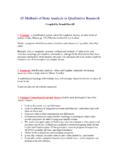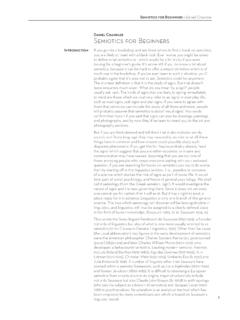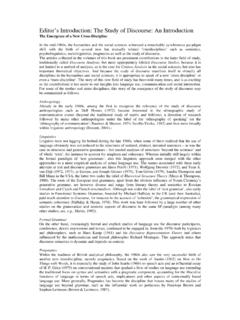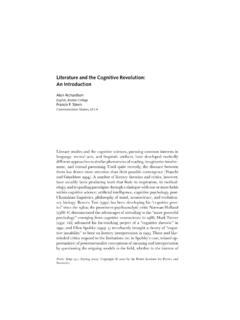Transcription of 15 Methods of Data Analysis in Qualitative Research
1 15 Methods of data Analysis in Qualitative Research Compiled by Donald Ratcliff 1. Typology - a classification system, taken from patterns, themes, or other kinds of groups of data . (Patton pp. 393,398) John Lofland & Lyn Lofland Ideally, categories should be mutually exclusive and exhaustive if possible, often they aren't. Basically a list of categories. example: Lofland and Lofland's 1st edition list: acts, activities, meanings, participation, relationships, settings (in the third edition they have ten units interfaced by three aspects--see page 114--and each cell in this matrix might be related to one of seven topics--see chapter seven). 2. Taxonomy (See Domain Analysis - often used together, especially developing taxonomy from a single domain.) James Spradley A sophisticated typology with multiple levels of concepts.
2 Higher levels are inclusive of lower levels. Superordinate and subordinate categories 3. Constant Comparison/Grounded Theory (widely used, developed in late 60's) Anselm Strauss Look at document, such as field notes Look for indicators of categories in events and behavior - name them and code them on document Compare codes to find consistencies and differences Consistencies between codes (similar meanings or pointing to a basic idea) reveals categories. So need to categorize specific events We used to cut apart copies of field notes, now use computers. (Any good word processor can do this. Lofland says Qualitative Research programs aren't all that helpful and I tend to agree. Of the Qualitative Research programs I suspect that NUD*IST probably the best--see Sage Publishers). Memo on the comparisons and emerging categories Eventually category saturates when no new codes related to it are formed Eventually certain categories become more central focus - axial categories and perhaps even core category.
3 4. Analytic Induction (One of oldest Methods , a very good one) F. Znaniecki, Howard Becker, Jack Katz. I wrote a paper on the topic. Look at event and develop a hypothetical statement of what happened. Then look at another similar event and see if it fits the hypothesis. If it doesn't, revise hypothesis. Begin looking for exceptions to hypothesis, when find it, revise hypothesis to fit all examples encountered. Eventually will develop a hypotheses that accounts for all observed cases. 5. Logical Analysis /Matrix Analysis An outline of generalized causation, logical reasoning process, etc. Use flow charts, diagrams, etc. to pictorially represent these, as well as written descriptions. Matthew Miles and Huberman gives hundreds of varieties in their huge book Qualitative data Analysis , 2nd ed. 6. Quasi-statistics (count the # of times something is mentioned in field notes as very rough estimate of frequency) Howard Becker Often enumeration is used to provide evidence for categories created or to determine if observations are contaminated.
4 (from LeCompte and Preissle). 7. Event Analysis /Microanalysis (a lot like frame Analysis , Erving Goffman) Frederick Erickson, Kurt Lewin, Edward Hall. Emphasis is on finding precise beginnings and endings of events by finding specific boundaries and things that mark boundaries or events. Specifically oriented toward film and video. After find boundaries, find phases in event by repeated viewing. 8. Metaphorical Analysis (usually used in later stages of Analysis ) Michael Patton, Nick Smith Try on various metaphors and see how well they fit what is observed. Can also ask participant for metaphors and listen for spontaneous metaphors. "Hallway as a highway." Like highway in many ways: traffic, intersections, teachers as police, etc. Best to check validity of metaphor with participants - "member check". 9.
5 Domain Analysis ( Analysis of language of people in a cultural context) James Spradley Describe social situation and the cultural patterns within it. Semantic relationships. Emphasize the meanings of the social situation to participants. Interrelate the social situation and cultural meanings. Different kinds of domains: Folk domains (their terms for domains), mixed domains, analytic domains (researcher's terms for domains). select semantic relationships prepare domain Analysis worksheet select sample of field notes (statements of people studied) look for broad and narrow terms to describe semantic relationships formulate questions about those relationships repeat process for different semantic relationship list all domains discovered 10. Hermeneutical Analysis (hermeneutics = making sense of a written text) Max Van Manen Not looking for objective meaning of text, but meaning of text for people in situation.
6 Try to bracket self out in Analysis - tell their story, not yours. Use their words, less interpretive than other approaches. Different layers of interpretation of text. Knowledge is constructed we construct meaning of text (from background and current situation - Social construction because of influence of others - symbolic interactionism) Use context - time and place of writing - to understand. What was cultural situation? Historical context. Meaning resides in author intent/purpose, context, and the encounter between author and reader - find themes and relate to dialectical context. (Some say authorial intent is impossible to ascertain.) Videotape - probably needs to be secondary level of Analysis . Get with another person who is using another method and analyze their field notes. 11. Discourse Analysis (linguistic Analysis of ongoing flow of communication) James Gee Usually use tapes so they can be played and replayed.
7 Several people discussing, not individual person specifically. Find patterns of questions, who dominates time and how, other patterns of interaction. 12. Semiotics (science of signs and symbols, such as body language) Peter Manning Determine how the meanings of signs and symbols is constructed. Assume meaning is not inherent in those, meaning comes from relationships with other things. Sometimes presented with a postmodernist emphasis. 13. Content Analysis (not very good with video and only Qualitative in development of categories - primarily quantitative) (Might be considered a specific form of typological Analysis ) R. P. Weber Look at documents, text, or speech to see what themes emerge. What do people talk about the most? See how themes relate to each other. Find latent emphases, political view of newspaper writer, which is implicit or look at surface level - overt emphasis.
8 Theory driven - theory determines what you look for. Rules are specified for data Analysis . Standard rules of content Analysis include: How big a chunk of data is analyzed at a time (a line, a sentence, a phrase, a paragraph?) Must state and stay with it. What are units of meaning?, the categories used. Categories must be: 1. Inclusive (all examples fit a category) 2. Mutually exclusive Defined precisely: what are properties All data fits some category (exhaustive) Also note context. Start by reading all way through, then specify rules. Could have emergent theory, but usually theory-driven. After determine categories, do the counting - how often do categories occur. Most of literature emphasizes the quantitative aspects. Originated with analyzing newspaper articles for bias - counting things in print.
9 Very print oriented - can it be adapted for visual and verbal? 14. Phenomenology/Heuristic Analysis (phenomenological emphasis - how individuals experience the world) Clark Moustakas Emphasizes idiosyncratic meaning to individuals, not shared constructions as much. Again, try to bracket self out and enter into the other person's perspective and experience. Emphasizes the effects of Research experience on the researcher-personal experience of the Research . How does this affect me as researcher. Much like hermeneutical Analysis , but even more focused on the researcher's experience. Some use the term "phenomenology" to describe the researcher's experience and the idea that this is all Research is or can ever be (see Lofland and Lofland, p. 14). 15. Narrative Analysis (study the individual's speech) Catherine Reisman Overlaps with other approaches.
10 (Is it distinctive?) Discourse Analysis looks at interaction, narrative is more individual) The story is what a person shares about self. What you choose to tell frames how you will be perceived. Always compare ideas about self. Tend to avoid revealing negatives about self. Might study autobiographies and compare them. context-situation core plot in the story told about self basic actions Narrative Analysis could involve study of literature or diaries or folklore. References Taxonomic Analysis : James P. Spradley (1980). Participant observation. Fort Worth: Harcourt Brace. Typological Systems: John Lofland & Lyn H. Lofland (1995). Analyzing social settings, 3rd ed. Belmont, Cal.: Wadsworth. Constant Comparison: Anselm L. Strauss (1987). Qualitative Analysis for social scientists. New York: Cambridge University Press.








